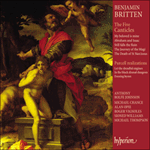Canticle II,
Abraham and Isaac, Op 51, followed in 1952, written for performance by Peter Pears, Kathleen Ferrier and Britten himself during a series of recitals which the three friends gave to raise funds for the English Opera Group. For his text, Britten turned not to the authorized version of the Bible, but to the lively dialogue and rich medieval language of the story as recounted in the Chester Miracle Plays. If Canticle I can be described as a miniature cantata, this second Canticle should surely be regarded as a miniature opera, such is the force of the drama as expressed through the music. The two human protagonists are naturally assigned to tenor and countertenor voices, but for the voice of God Britten hit on the idea of making the two voices sing together in homophony, thus producing a mysterious new timbre which could not have been obtained from a third solo singer. The Canticle is divided into several short sections, reflecting the progress of the drama as it unfolds up to the climactic intervention of God at the moment of sacrifice, the work ending with a hymn of thanksgiving.
from notes by Michael Short © 1992
Le deuxième Cantique,
Abraham and Isaac fut écrit en 1952 et interprété par Peter Pears, Kathleen Ferrier et Britten en personne au cours d’une série de récitals que les trois amis donnèrent pour procurer des fonds à l’English Opera Group. Britten choisit pour texte non pas la Bible dans sa traduction de 1611, mais le dialogue vivant et le riche langage médiéval de l’histoire telle qu’elle est racontée dans les Miracles de Chester. Si le premier Cantique peut être décrit comme une cantate miniature, le deuxième est quant à lui un opéra miniature, tant est fort le drame exprimé par la musique. Les deux protagonistes humains sont naturellement assignés aux voix ténor et alto, mais Britten eut l’idée de représenter la voix de Dieu par les deux voix en homophonie, produisant ainsi un mystérieux timbre nouveau qu’il n’aurait pas pu obtenir d’un troisième soliste. Le Cantique est divisé en plusieurs brèves sections, qui reflètent le déroulement du drame jusqu’à son apogée avec l’intervention divine au moment du sacrifice, et l’œuvre s’achève sur un hymne d’action de grâces.
extrait des notes rédigées par Michael Short © 1992
Français: Elisabeth Rhodes
Das II. Canticle
Abraham and Isaac, folgte 1952 und wurde zur Aufführung durch Peter Pears, Kathleen Ferrier und Britten selbst im Rahmen einer Serie von Liederabenden geschrieben, welche die drei Freunde zugunsten der English Opera Group gaben. Auf der Suche nach seinem Text wandte sich Britten nicht der offiziellen Bibelversion zu, sondern dem lebendigen Dialog und dem deftigen mittelalterlichen Vokabular der biblischen Geschichte, wie sie die Chester Miracle Plays nacherzählen. Die beiden menschlichen Protagonisten werden natürlich von Tenor und Alt dargestellt. Dagegen kam Britten in Bezug auf die Stimme Gottes der Gedanke, die beiden Stimmen zusammen in Homophonie singen zu lassen, woraus sich ein geheimnisvolles neues Timbre ergab, das mit einem dritten Gesangssolisten nicht zu erzielen gewesen wäre. Das Canticle ist entsprechend dem Ablauf des Dramas bis zu seinem Höhepunkt, dem Eingreifen Gottes im Augenblick des Opfers, in mehrere kurze Abschnitte aufgeteilt, und das Werk endet mit einer hymnischen Danksagung.
aus dem Begleittext von Michael Short © 1992
Deutsch: Anne Steeb/Bernd Müller



 Britten: The Five Canticles
Britten: The Five Canticles
